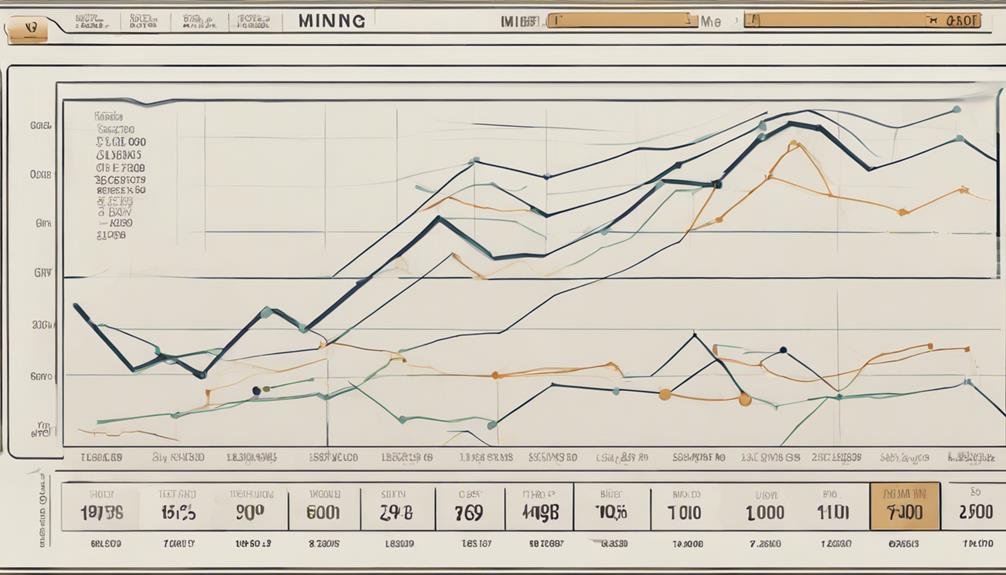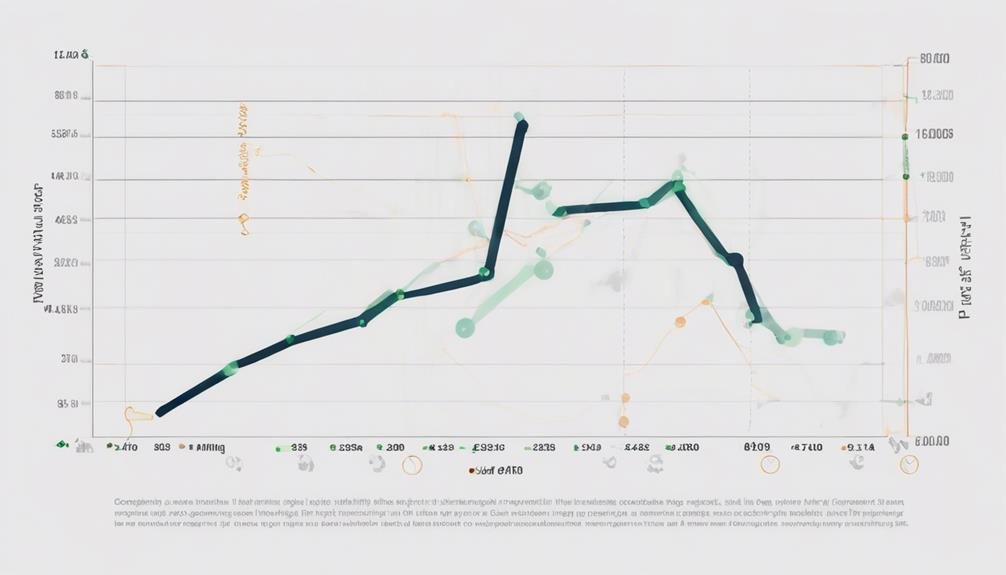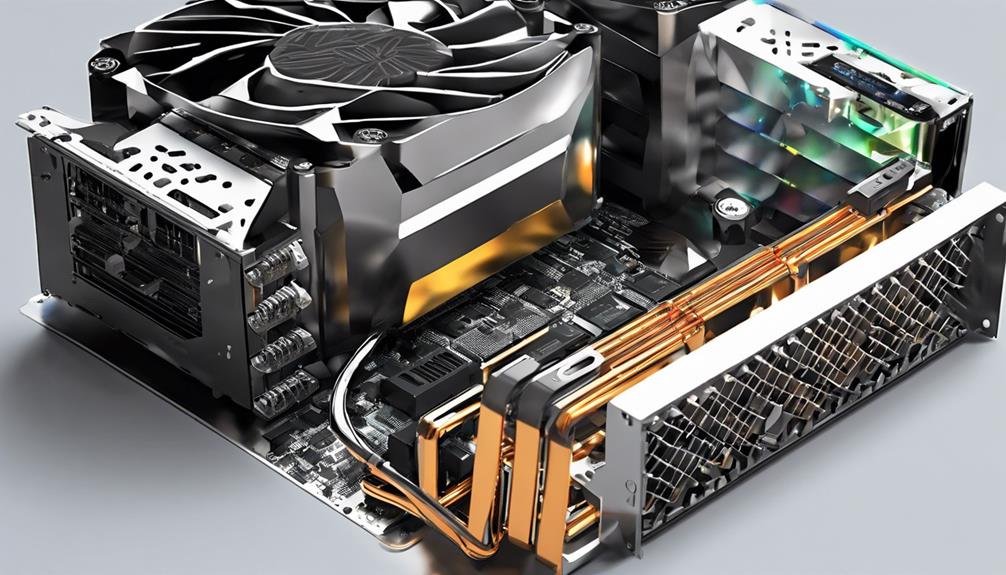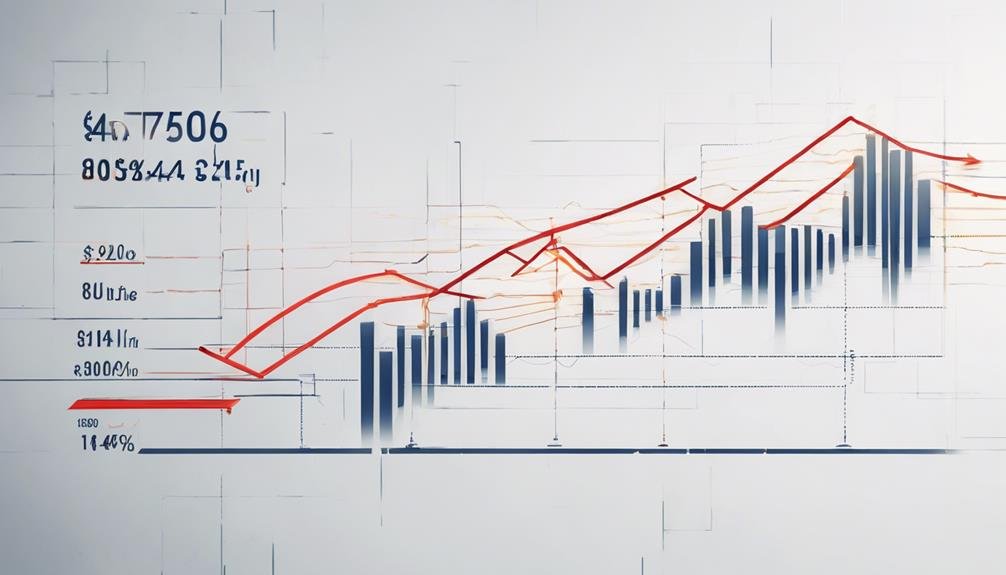Higher hash rates enhance mining efficiency by completing more computations quickly, increasing the chances of successfully mining blocks. Upgrading hardware may be needed to match rising hash rates. Adapting can lead to more transaction fees and rewards. More hash power means faster reward accumulation. Understanding the impact of rewards is vital for maximizing profitability. The hash rate affects mining difficulty, influencing competitiveness. Balancing hash rate and costs is essential for profitability. Peak hash rate levels maximize earnings. Hash rate management is critical for efficient operations. Learn more about how hash rate shapes mining profits for successful operations.
Table of Contents
Brief Overview of Impact of Hash Rate on Mining Profitability
- A higher hash rate increases mining efficiency and profitability by completing more computations.
- A rising hash rate leads to faster block discoveries and increased reward accumulation.
- Competition among miners intensifies with higher hash rates, impacting individual profitability.
- Balancing hash rate and operational costs is crucial for maximizing profitability.
- Efficient hash rate management is essential for optimizing power consumption and mining profitability.
Impact of Increasing Hash Rate
As the hash rate increases, your mining efficiency and profitability can significantly improve due to completing more computations in a given time. A higher hash rate means your mining hardware can process more calculations, increasing your chances of successfully mining blocks and earning rewards. This improved efficiency translates into higher profitability as you can participate in more mining activities within the same timeframe.
To maintain this competitiveness, you may need to upgrade your mining hardware to keep up with the rising hash rate. Investing in more advanced equipment can help you sustain or even boost your profitability in the long run. By adapting to the increasing hash rate, you position yourself to earn more transaction fees and block rewards. This adjustment not only benefits you individually but also contributes to the overall network security and stability, attracting more participants to the mining ecosystem and fostering a healthier environment for all miners.
Influence on Mining Rewards

When the hash rate increases, it directly impacts your mining rewards. The correlation between a higher hash rate and more frequent block discoveries means you can accumulate rewards faster over time. Understanding how hash rate influences mining rewards is critical to maximizing profitability and staying competitive in the mining ecosystem.
Mining Reward Fluctuations
Mining profitability can be significantly impacted by the fluctuation of mining rewards, directly influencing the earnings miners receive for completing block validations. In the Bitcoin mining sector, mining reward fluctuations play an important role in determining overall profitability. Events like halving events or changes in transaction fees can lead to decreases in mining rewards, affecting the bottom line for miners.
Understanding these fluctuations is essential for miners to adapt their strategies and remain profitable in the long term. Effective management of mining reward fluctuations is critical to maximizing profitability and staying competitive in the mining sector. By staying informed and proactive in response to these changes, miners can navigate the challenges posed by fluctuating rewards and maintain a sustainable mining operation.
Hash Rate Correlation
The correlation between hash rate and mining rewards dramatically impacts the profitability of miners in the cryptocurrency ecosystem. A higher hash rate boosts block-solving capabilities, directly increasing mining rewards. Miners with elevated hash rates enjoy a competitive advantage, as their chances of successfully mining blocks and earning rewards more frequently are enhanced. Conversely, lower hash rates may lead to slower block-solving times, resulting in reduced overall mining rewards.
This relationship underscores the importance of optimizing the hash rate to maximize mining profitability. By increasing the hash rate, miners can improve their efficiency and competitiveness in the network. Balancing power consumption with network hash rate is crucial for miners to achieve peak mining profitability and stay ahead in the competitive mining landscape.
Reward Calculation Impact
Optimizing the hash rate directly impacts the calculation of rewards in cryptocurrency mining, influencing miners’ profitability to a great extent. A higher hash rate increases the likelihood of successfully mining a block, leading to more frequent rewards and, ultimately, higher mining profitability. This efficiency can be further enhanced with advanced mining hardware, maximizing miners’ earnings potential.
Conversely, a lower hash rate may prolong block-solving times, diminishing overall rewards and impacting profitability negatively. Fluctuations in hash rate play an important role in determining the amount of cryptocurrency rewards received by miners, directly affecting their bottom line. Understanding the relationship between hash rate and reward calculations is pivotal for miners to fine-tune their setups effectively and optimize their profitability in the competitive landscape of cryptocurrency mining.
Relationship With Mining Difficulty

When hash rates increase, mining difficulty also rises, impacting the profitability of miners. This correlation means that as more miners join the network with higher hash rates, it becomes harder to mine new blocks. As a result, maintaining profitability in the face of fluctuating hash rates and difficulty adjustments requires miners to adapt their hardware and strategies constantly.
Difficulty Adjustment Impact
Understanding the complex connection between hash rate and mining difficulty is crucial for grasping how profitability in mining operations fluctuates. The difficulty adjustment directly impacts mining profitability by altering the level of complexity in solving cryptographic puzzles. As more miners join the network, the difficulty increases, requiring additional computational power and time to mine a block. Conversely, decreased difficulty results in faster block times.
Bitcoin adjusts its difficulty every 2,016 blocks to regulate block-solving time and maintain the desired production rate. This relationship between hash rate and mining difficulty influences the competitiveness and profitability of crypto mining operations, affecting factors such as power consumption, operating systems, and overall blockchain technology efficiency.
Profitability Fluctuation Correlation
The relationship between hash rate and mining difficulty significantly impacts the profitability of mining operations, shaping the competitive landscape for miners. When the network’s hash rate increases, the mining difficulty also escalates to make sure that blocks are generated at a consistent rate. This adjustment can impact mining profitability by making it more challenging for miners to solve blocks efficiently.
Higher hash rates can result in increased power consumption, potentially affecting the overall costs of mining. As competition intensifies due to higher hash rates, individual miners may experience a decrease in profitability. Understanding how changes in hash rate influence mining difficulty is crucial for optimizing mining operations and maneuvering the fluctuations in profitability within the mining ecosystem.
Effects on Competition Among Miners

With a higher hash rate, miners compete more fiercely to secure block rewards swiftly. The increased competition among miners due to higher hash rates can have a direct impact on individual profitability. Miners with higher hash rates stand a better chance of earning block rewards, potentially leaving those with lower hash rates at a disadvantage. Miners must strike a balance between their hash rate and operational costs to maintain profitability in this competitive environment.
As the competition intensifies, miners must consider the trade-off between increasing their hash rate for better chances of securing rewards and the operational costs involved in doing so. Ideal hash rate levels allow miners to stay competitive and maximize their profitability in the mining ecosystem. However, operational costs outweigh the rewards earned due to fierce competition. In that case, miners may need to reassess their strategies to guarantee sustainable profitability. Balancing these factors is critical to efficiently maneuvering the competitive landscape of mining.
Consideration in Profit Calculations

When calculating profits in mining, it is essential to factor in various costs and efficiencies to determine true profitability. One crucial aspect to take into account is the hash rate, as it directly impacts mining profitability by affecting the speed and efficiency of solving cryptographic puzzles. Higher hash rates increase the chances of successfully mining a block faster, leading to more frequent rewards. To optimize mining profitability, it is crucial to optimize the hash rate through efficient hardware, software, and pool selection.
By enhancing efficiency in power consumption and overall operations, miners can improve their mining profitability. Mining profitability calculations typically include electricity costs, hardware expenses, and the network’s current difficulty level. Understanding how hash rate influences mining profitability is critical to making informed decisions and maximizing returns on mining investments. By efficiently managing power consumption and optimizing hash rate, miners can enhance their profitability in the competitive mining landscape.
Impact on Electricity Costs

Taking into account the impact of hash rate on electricity costs is vital for evaluating mining profitability accurately. Electricity costs directly influence mining profitability as they contribute to the operational expenses of running mining equipment. A high hash rate can result in increased power consumption, leading to higher electricity costs and potentially reducing overall profitability. However, by utilizing efficient mining hardware, miners can strike a balance between a high hash rate and lower power consumption, ultimately improving their profitability.
Miners need to monitor and manage electricity costs in relation to hash rate to maximize profitability in a competitive mining environment. Finding the proper equilibrium between hash rate, electricity costs, and mining rewards is crucial for optimizing mining profitability. By staying mindful of these factors and investing in efficient hardware, miners can enhance their profitability and remain competitive in the mining landscape.
Importance for Mining Optimization

Why is optimizing the hash rate vital for maximizing mining profitability? In Bitcoin mining, the hash rate directly influences your power consumption and, consequently, your energy costs. By efficiently managing your hash rate, you can strike a balance between the energy expended and the rewards gained, ultimately enhancing your mining profitability. Higher hash rates not only increase the chances of solving blocks faster but also lead to more efficient mining operations, potentially resulting in higher rewards for miners.
It is essential to focus on optimization strategies to guarantee that your mining operation remains profitable. Properly optimizing your hash rate can significantly improve your financial performance in the mining industry. By paying close attention to your hash rate and implementing effective optimization techniques, you can boost your mining profitability and stay competitive in the ever-evolving world of cryptocurrency mining.
Frequently Asked Questions
How Does Hashrate Affect Mining?
A higher hash rate boosts mining efficiency, leading to more frequent rewards. It directly impacts your profit margins by quickening block mining. Monitoring power consumption, hardware efficiency, network difficulty, and cooling solutions is crucial for maximum earnings.
How Much Hash Rate Is Good for Mining?
To find the sweet spot for mining success, aim for an ideal hash rate that balances efficiency and costs. Upgrading hardware, monitoring power use, and adjusting to network challenges can boost rewards while keeping your profitability strong.
What Determines Mining Profitability?
To determine mining profitability, consider hardware requirements, electricity costs, pool mining, network difficulty, mining rewards, and maintenance costs. Optimizing these factors will help you maximize profits and guarantee sustainable mining operations.
How Do You Increase Hash Rate in Mining?
To increase hash rate in mining, upgrade hardware for efficiency, use cooling solutions to maintain temperatures, overclock smartly to boost performance, join a pool for shared resources, prioritize energy efficiency, and optimize software settings regularly.
Conclusion
As you’ve learned, the hash rate plays a pivotal role in determining mining profitability. It impacts rewards, competition, difficulty, and electricity costs. Understanding how these factors interact is critical to optimizing your mining operations. So, keep an eye on your hash rate and make adjustments as needed to stay ahead in the game. Just like a well-oiled machine, your mining setup should be finely tuned for maximum efficiency.




